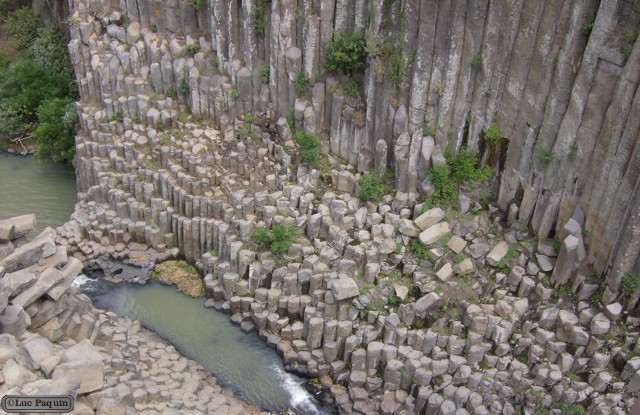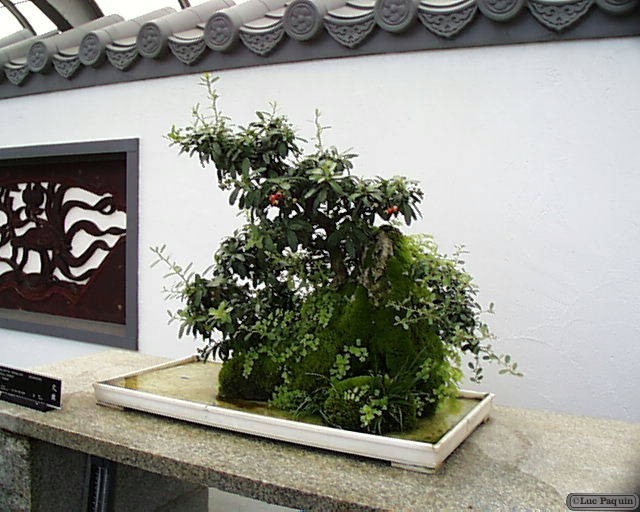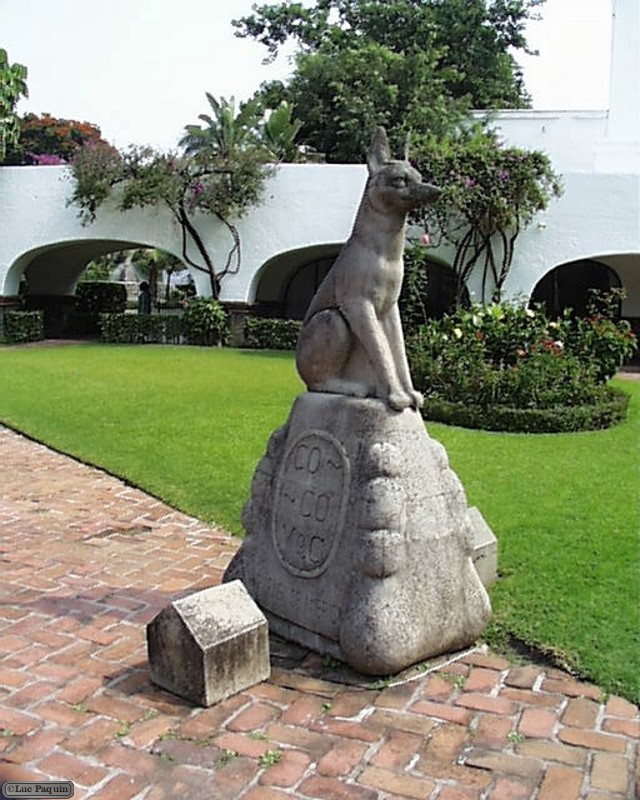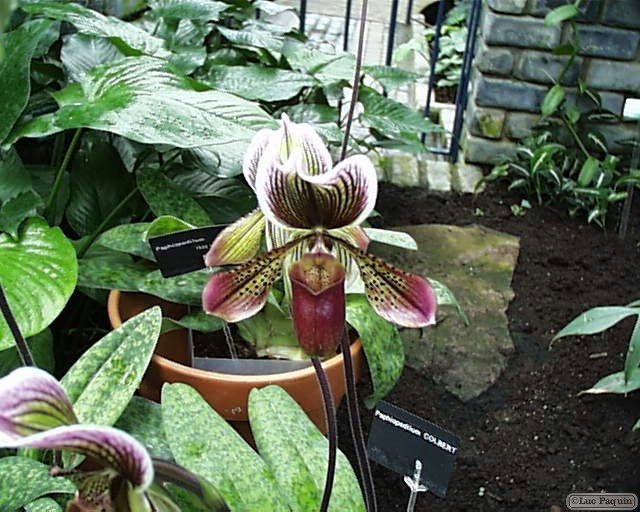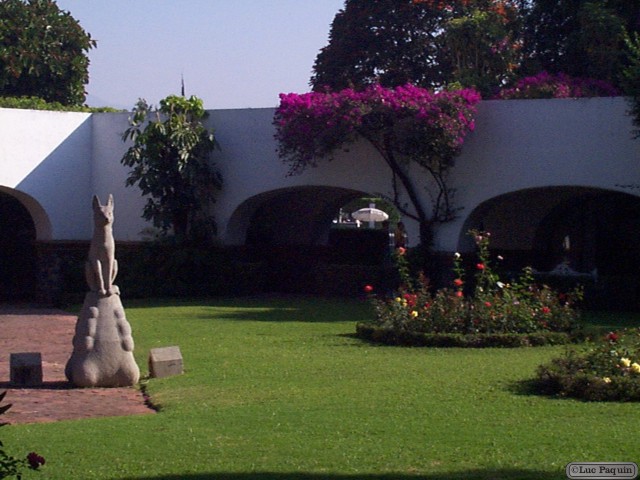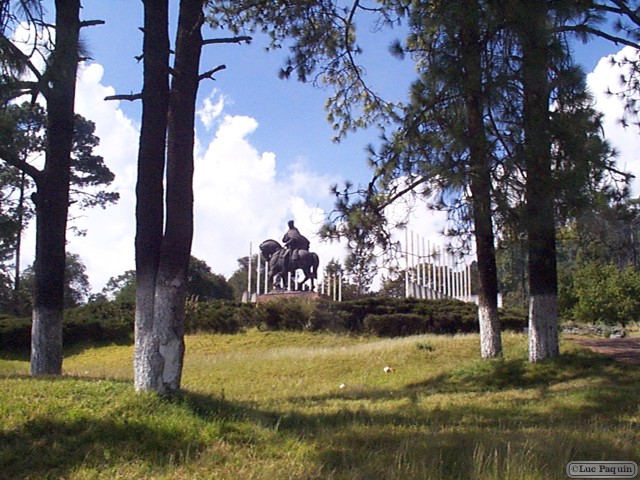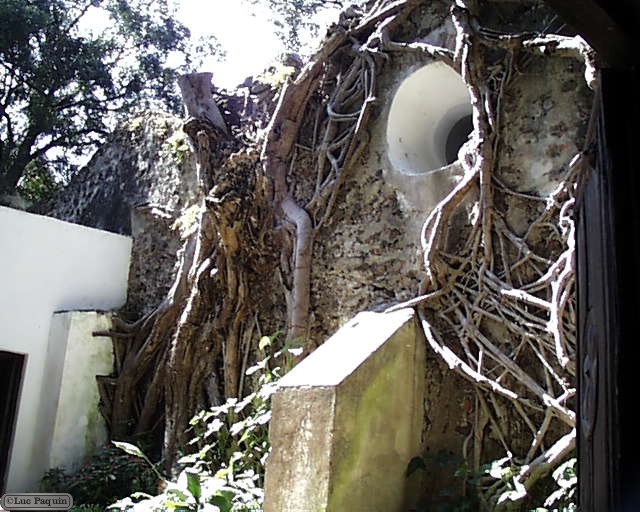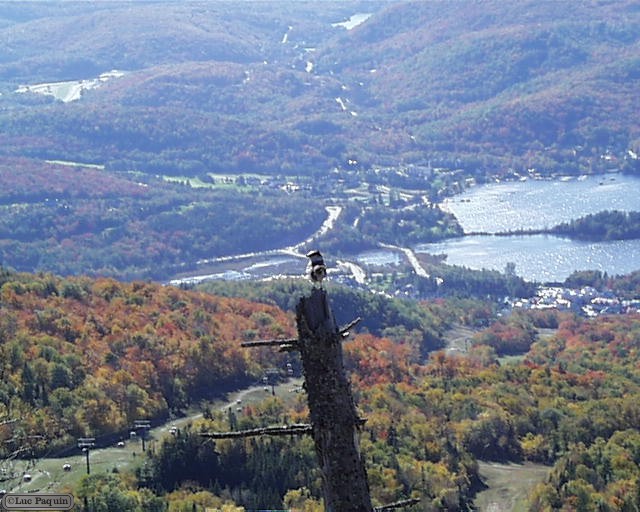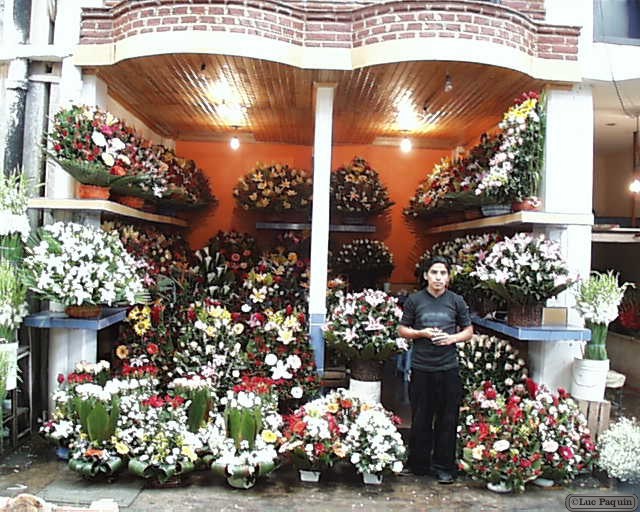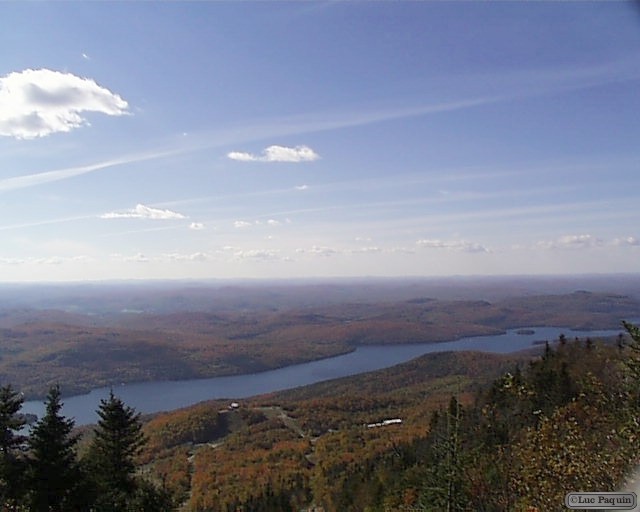LucPaquin
Year: 2007 (March 25, 2007)
11″ x 8.5″
Media: Canon® Pro Platinum High Gloss Photo Paper
Printers: Canon® PIXMA
Color
Art: Photo
Artist: Luc Paquin
Huasca de Ocampo
Prismas Basálticos
Los Prismas Basálticos (The Basalt Prisms) are tall columns of basalt rock that line a ravine through which water runs from the San Antonio Dam. This ravine area was part of the Santa María Regla Hacienda and was first promoted by Alexander von Humboldt in 1803.
The walls of the canyon, called the Barranca de Alcholoya, are lined by polygonal columns between thirty and fifty meters high with five or six sides. The basalt columns were created by the slow cooling of volcanic lava. The visible columns are backed by even more polygonal basalt columns. There are two waterfalls. The higher one has its water supplemented by diversions from nearby dams. The lower one is called the Cascada de la Rosa. The canyon has been prepared by the addition of stairs, walkways and hanging bridges for easy access.
Luc
Year: 1998 (July 22, 1998)
11″ x 8.5″
Media: Canon® Pro Platinum High Gloss Photo Paper
Printers: Canon® PIXMA
Color
Art: Photo
Artist: Luc Paquin
Montreal Botanical Garden
The Chinese Garden
The Chinese Garden is constructed along the traditional lines for a Ming Dynasty Chinese garden. Covering 2.5 hectares, it has many winding paths, an artificial mountain, and a building in the Chinese style housing a collection of bonsai and penjing that have been donated. The garden is populated with Chinese plants. The garden was constructed from 1990-1991 by 50 artisans from the Shanghai Institute of Landscape Design and Architecture, directed by Le Weizhong. The project required 120 containers of material imported from Shanghai, including 500 tonnes of stone from Lake Tai in Jiangsu province.
Luc
Year: 1998 (November 13, 1998)
8.5″ x 11″
Media: Canon® Pro Platinum High Gloss Photo Paper
Printers: Canon® PIXMA
Color
Art: Photo
Artist: Luc Paquin
Hotel Hacienda Cocoyoc
Coyote
The coyote (Canis latrans) is a canid native to North America. It is a smaller, more basal animal than its close relative, the gray wolf, being roughly the North American equivalent to the old world golden jackal, though it is larger and more predatory in nature. It on account of its wide distribution and abundance throughout North America, even southwards through Mexico and Central America. It is a highly versatile species, whose range has expanded amidst human environmental modification. This expansion is ongoing, and it may one day reach South America, as shown by the animal’s presence beyond the Panama Canal in 2013.
The ancestors of the coyote diverged from those of the gray wolf, 1-2 million years ago, with the modern species arising in North America during the Middle Pleistocene. It is highly flexible in social organization, living either in nuclear families or in loosely-knit packs of unrelated individuals. It has a varied diet consisting primarily of animal matter, including ungulates, lagomorphs, rodents, birds, reptiles, amphibians, fish and invertebrates, though it may also eat fruit and vegetable matter on occasion. It is a very vocal animal, whose most iconic sound consists of a howl emitted by solitary individuals. Humans aside, cougars and gray wolves are the coyote’s only serious enemies.
The coyote is a prominent character in Native American folklore, usually depicted as a trickster who alternately assumes the form of an actual coyote or a man. As with other trickster figures, the coyote acts as a picaresque hero which rebels against social convention through deception and humor. The animal was especially respected in Mesoamerican cosmology as a symbol of military might, with some scholars having traced the origin of the Aztec god Quetzalcoatl to a pre-Aztec coyote deity. After the European colonization of the Americas, it was reviled in Anglo-American culture as a cowardly and untrustworthy animal. Unlike the gray wolf, which has undergone a radical improvement of its public image, cultural attitudes towards the coyote remain largely negative.
Luc
Year: 1998 (July 22, 1998)
11″ x 8.5″
Media: Canon® Pro Platinum High Gloss Photo Paper
Printers: Canon® PIXMA
Color
Art: Photo
Artist: Luc Paquin
Montreal Botanical Garden
Lady’s Slipper Orchids
Lady’s slipper orchids are orchids in the subfamily Cypripedioideae. They are characterised by the slipper-shaped pouches (modified labellums) of the flowers – the pouch traps insects so they are forced to climb up past the staminode, behind which they collect or deposit pollinia, thus fertilizing the flower. Unlike other orchids, Cypripedioideae have two fertile anthers – they are “diandrous”.
The Cypripedium genus is found across much of North America, as well as in parts of Europe and Asia. The pink lady’s slipper is also the official provincial flower of the Canadian province of Prince Edward Island.
Paphiopedilums are found in the tropical forests of southeast Asia reaching as far north as southern China. Paphiopedilum is quite easy to cultivate and therefore is popular among orchid enthusiasts. In fact, overcollecting of this genus has been so extensive that many species are now sub-viable in their natural habitats. Phragmipedium, found across northern South and Central America, is also easy to cultivate as it requires lower temperatures than Paphiopedilum, eliminating the need for a greenhouse in many areas.
The lady’s slipper is also known in the United States of America as the moccasin flower, from its resemblance to a moccasin.
Luc
Year: 2000 (November 25, 2000)
11″ x 8.5″
Media: Canon® Pro Platinum High Gloss Photo Paper
Printers: Canon® PIXMA
Color
Art: Photo
Artist: Luc Paquin
Hotel Hacienda Cocoyoc
Cocoyoc is a Nahuatl word that means “the place of coyotes”. The town of Cocoyoc is many centuries old and existed long before the Spanish conquest. It was founded in the eleventh century by the Tlahuican, another Nahuatl group, two hundred years before the Aztecs became the dominant group of the Nahuatls and established their capital — Tenochtitlan — where Mexico City now stands.
Huitzihuitl, the second king of the Aztecs, conquered Cocoyoc, as he became impressed by its excellent weather, fertile land and lush vegetation, taking as his wife the daughter of the conquered lord. Of this marriage, Moctezuma I was born, who goberned the Aztec Empire from 1440 to 1469. Moctezuma I, attracted by his mother’s land, ordered extensive gardens to be planted near Cocoyoc — bringing flowers, trees and bushes from all over the country. He had royal baths constructed for his own use and would go there to escape from state affairs; to relax in the sun and the peacefull atmosphere of Cocoyoc.
Cocoyoc was part of the vast territory given to Hernan Cortes after the Conquest of Mexico in 1521. He was named Marquis of Oaxaca in recognition of his services to the Spanish crown and then proceed to establish a firm hold on the land. Cortes also married Isabel, daughter of Moctezuma II, who was the Aztec ruler at that time. Soon thereafter, the fertile land of the valley and of all the State of Morelos was planted with sugar cane, which had been introduced by the Spaniards.
Luc
Year: 2000 (November 24, 2000)
11″ x 8.5″
Media: Canon® Pro Platinum High Gloss Photo Paper
Printers: Canon® PIXMA
Color
Art: Photo
Artist: Luc Paquin
Cuernavaca-Ciudad De Mexico 95D
Jose Maria Morelos – Monument to Morelos, Morelos
José María Teclo Morelos y Pavón (September 30, 1765, City of Valladolid, now Morelia, Michoacán – December 22, 1815, San Cristóbal Ecatepec, State of México) was a Mexican Roman Catholic priest and revolutionary rebel leader who led the Mexican War of Independence movement, assuming its leadership after the execution of Miguel Hidalgo y Costilla in 1811. He was later captured by the Spanish colonial authorities and executed for treason in 1815.
Luc
Year: 1998 (November 13, 1998)
11″ x 8.5″
Media: Canon® Pro Platinum High Gloss Photo Paper
Printers: Canon® PIXMA
Color
Art: Photo
Artist: Luc Paquin
Hotel Hacienda Cocoyoc
Welcome to the Hotel Hacienda Cocoyoc, and Hacienda Resort and “The Paradise of America”. Surrounded by lush semi-tropical vegetation, this Hacienda Resort combines modern amenities and conveniences with the beauty of sixteenth-century architecture and tradition, resulting in a unique blend designed for your maximum comfort.
The are no elevators at this Hacienda Resort. Instead, you will find unlimited greenery, luscious gardens, fountains and bordered walkways. At an elevation of 4,000 feet above sea level and an average annual temperature of 68° F with clean, clear breezes blowing from the nearby snow-capped volcanoes, the perfect conditions are achieved for outdoor recreation and enjoyment.
Luc
Year: 2001 (October 2, 2001)
11″ x 8.5″
Media: Canon® Pro Platinum High Gloss Photo Paper
Printers: Canon® PIXMA
Color
Art: Photo
Artist: Luc Paquin
Mont-Tremblant, Quebec, Canada
Constructed by Joseph Bondurant Ryan, the ski resort Mont Tremblant Lodge began operation of their first chair lift in 1939. His family sold the resort in 1965 to a consortium of investors.
In 2002 the four municipalities in the area merged, Ville St. Jovite, Paroisse de Saint-Jovite, Mont-Tremblant, and Lac-Tremblant-Nord, becoming the amalgamated Ville de Mont-Tremblant. Afterwards the Municipality of Lac-Tremblant-Nord separated, effective 2006.
Luc
Year: 2004 (Mach 18, 2004)
11″ x 8.5″
Media: Canon® Pro Platinum High Gloss Photo Paper
Printers: Canon® PIXMA
Color
Art: Photo
Artist: Luc Paquin
Mercado de Jamaica
In Spanish, jamaica means the hibiscus flower.
This market is housed in three large naves covering a city block on the corner of Congreso de la Unión and Avenida Morelos in the Venustiano Carranza borough. The Metro Jamaica station on Line 9 is directly in front of the building. The market is one of the principal ones for fruits, vegetables, flowers and ornamental plants in the city and is bustling to chaotic, especially on weekends.
The market is best known for the sale of flowers and ornamental plants. There are 1,150 stands dedicated to flowers, flower arrangements and ornamental plants and associated accessories. 25.5% sell cut flowers, 26% sell flower arrangements, 4.3% sell flower pots and other accessories, 40.9% of the stalls are reserved for the trucks of flower producers and sellers and 3.2% sell ornamental plants, including those from the wild. The market sells about 5,000 types flowers and ornamental plants from the states of Puebla, Veracruz, Chiapas, Oaxaca, State of Mexico and Michoacán. The variety of flowers is wide from roses to those from the various tropics. There are both retail and wholesale sales, mostly to florists in Mexico City, but sales are also made to some of the surrounding states. There are even exports to the United States and Haiti.
Luc
Year: 2001 (October 2, 2001)
11″ x 8.5″
Media: Canon® Pro Platinum High Gloss Photo Paper
Printers: Canon® PIXMA
Color
Art: Photo
Artist: Luc Paquin
Mont-Tremblant, Quebec, Canada
The area was first settled in 1872 by parish priest Antoine Labelle, leading to formal establishment of the parish in 1879. A railway line from Montreal was completed to the village of St. Jovite in 1892, and extended to Lac Mercier in 1904. The Lac Mercier station would become the village of Mont Tremblant. In 1905 a hydroelectric dam was erected on the banks of the Ruisseau Clair and the Riviere du Diable, providing electricity initially for St. Jovite. Principal economic activities were agriculture and logging.
Luc
